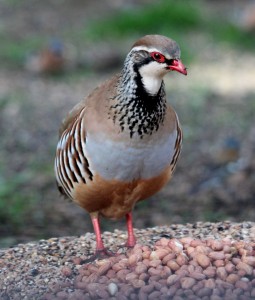 It is always interesting that many of the birds introduced to the UK are extremely attractive, even flamboyant. For example the cock pheasant, the male mandarin duck and, perhaps to slightly lesser extent, the red-legged partridge. The mandarin ducks have come from deliberate releases or escapes from private collections. As for the pheasant and red-legged partridges, they both rely heavily on large numbers introduced each year for shooting purposes. As for the red-legged partridge, the photograph shows the combination of colours even with a front view. This bird was one of a pair that came into my garden last week and the one in the photograph was about to tuck into the pile of peanuts I had put out for the badgers to feed on.
It is always interesting that many of the birds introduced to the UK are extremely attractive, even flamboyant. For example the cock pheasant, the male mandarin duck and, perhaps to slightly lesser extent, the red-legged partridge. The mandarin ducks have come from deliberate releases or escapes from private collections. As for the pheasant and red-legged partridges, they both rely heavily on large numbers introduced each year for shooting purposes. As for the red-legged partridge, the photograph shows the combination of colours even with a front view. This bird was one of a pair that came into my garden last week and the one in the photograph was about to tuck into the pile of peanuts I had put out for the badgers to feed on.
Red-legged partridges were deliberately introduced to southern Britain as long ago as 1673 as a game bird for shooting. In Scotland the releases were much later but were unsuccessful because of the weather. However, in Scotland by 1963 commercial rearing became more widespread. At present in the whole of Scotland there may only be 500 pairs that survive each year so the numbers have to be annually augmented by large numbers of birds that are reared solely for shooting. They are not so popular as the native grey partridge that is drastically declining. One reason for this is the habit of the red-legged partridge to run rather than fly and there is not much in shooting the birds on the ground! Many people used to think that the grey partridge was ousted by the slightly larger red-legged partridge but this has been shown by studies not to be the case. The red-legged partridge is reared in roughly the same way as pheasants and are much prized by sportsmen who pay large amounts of money to attend organised shoots. The birds are mainly reared in the more suitable parts of the Highlands and are more or less confined to an area around Inverness and to the east. There is a small population up on the east coast but elsewhere they are rather a rare bird. The Black Isle is a good place to see them as the combination of farmland and rough grassland is ideal for them.
Red-legged partridges not only have a problem with the Highland weather but also with predators. This is mainly because they nest on the ground and rely on camouflage to outwit their many predators. Carrion and hooded crows are the main culprits but the ground nests and eggs are raided by many other species from foxes to stoats and pine martens to badgers. In the breeding season the males make several shallow scrapes on the ground which are more or less depressions with very little lining. The female then chooses one and lays 10-16 eggs. Interestingly, many pairs lay a second clutch and this may be brooded by the male with the female covering the other clutch. The end result is that if there is only one clutch of chicks both parents tend them but if there are two clutches then the male will take charge of one and the female the other. Eventually, however, both clutches join together. So at this time of the year if you see a pair of these partridges they will be from birds that were released last year or even before and have survived the winter. The male and female plumage is roughly the same but the female is slightly smaller than the male.
